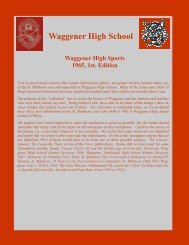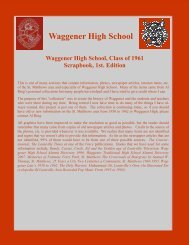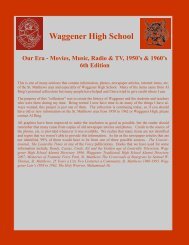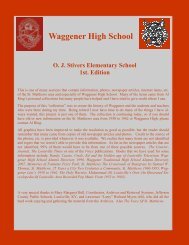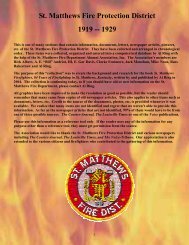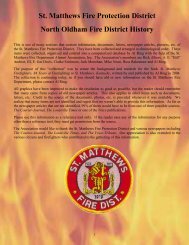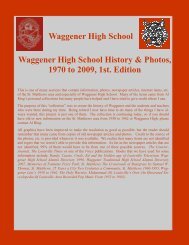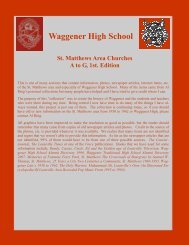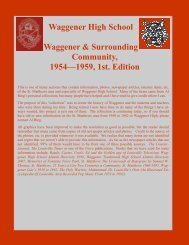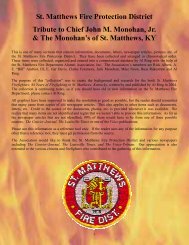The Voice, July 25, 1974:25th Anniversary IssueHe wanted to be fair. So on February 9 he denounced annexation by Louisville, and the following week outlined argumentsin favor of annexation. One thing was certain, he said, ‘something must be done.”When the Municipal League reported 69 percent of those polled favored incorporation, Jimmy came out in favor of Incorporation.Tell-tale size: The February 16 edition increased one inch in depth, signifying that The Voice had changed printers. OnMarch 16, it shrank back an inch. Jimmy had changed printers again, as his credit ran out, it increased an inch and shrankback once more in the next year, until The Voice finally went full-size for good.On May 25, 1950, one of the strangest editorials in Kentucky journalism appeared in The Voice, it said in part:“This newspaper has used a policy unheard of in journalistic circles. We have believed everyone without reservation . . .The time has arrived for clear, unbiased reporting . . . This plan may hurt many individuals and undoubtedly make enemies,but the truth must replace fiction . . From this day forward, if any reported fraud, deceit, distortion of truth, or dishonesty isuncovered by this office, it will appear in print….”There wasn’t anything in the paper to explain what he was talking about, and I haven’t any idea.Jimmy succeeded Howard Hunt as president of the St. Matthews Chamber of Commerce in June, 1950. “No one is helpedby the surly witticisms thrown at organizations that are trying to build the <strong>com</strong>munity,” wrote Jimmy in July. ‘Before youjudge a group, join it.” The organization collapsed shortly afterwards.Jimmy was a colorful character, as you may have gathered by now, in a profession that spawns picturesque personalities.Most St. Matthews merchants loved him, and his escapades have be<strong>com</strong>e part of the local legend.He hired me in September, 1950, on the strength of my uncle’s re<strong>com</strong>mendation (or his razor). I was a senior at the Universityof Louisville, majoring in English, and was managing editor of the Cardinal, the school’s weekly. I worked for Jimmyon Saturday. His office was in the Post Office Building at Breckenridge Lane and Willis, we shared it with a stove salesman.Sophie Elliott was bookkeeper. Jimmy was editor and publisher. Jimmy paid me $5 a week, which, after taxes and transportation,boiled down to a cool $3.35. The first two stories I wrote for him were a feature on the Kentucky Farm Bureau,which was built here in 1948, and a story about Robert Kraft, 3827 Ormond Road, who had broken his leg while paintinghis house.I would report to the office at 9 am on Saturday. Usually it was deserted, and first I would read the <strong>com</strong>petition, The St.Matthews Sun, also a tabloid, which started, I believe, in 1933, and went out of business—towards the end of 1953.The Sun was owned and published by Tom Jones, of Jeffersontown, a good newsman who also published the Jeffersonian,but no businessman. Tom could never remembered to bill his advertisers. St. Matthews jeweler Charlie Lester told me heand another businessman, determined to get their bills from Tom, once lay in wait for him at an intersection he passed eachmorning.After reading the Sun, I would call several sources for news -- Kenneth Farmer, principal of Greathouse <strong>School</strong>, the onlyelementary school in St. Matthews until Stivers was built In 1952 or 1953; Ed Kaiser, secretary of the St. Matthews Y; severalchurches; and the St. Matthews Volunteer Fire Department. We did not go in for investigative reporting. The paper wasa throwaway and we just needed enough copy to fill in around the ads. A hard day’s work by me on Saturday would normallyfill the front page and several inside pages. Jimmy filled out the rest with social news contributed by Ruth Noe Paine.Basil Willis, a Greyhound bus driver, was our part-time photographer. Basil charged $1 a print. But he had a bad habit ofalways setting the focus on his camera at infinity. Consequently most of his pictures were blurred. Jimmy nicknamed him“Out of Focus” Willis and claimed the only sharp picture he ever took was once when he tripped and fired the camera accidentally,getting a perfect exposure of his shoe.Jimmy put out a beautiful Christmas edition that year. The Smithers’ Grocery ad was in red and green. Jimmy’s Christmasmessage read, in part, “Shelbyville Road will continue to be covered in blood until the County Police leave the <strong>com</strong>parativesafety of the St. Matthews White Castle restaurant and begin a real campaign against the murderers of the highway.”In the next issue, he refused to apologize, and gave the police another salvo. The Voice carried a story the Our Lady ofLourdes held first Masses in its new Sanctuary. Jimmy note: “We now have 10 churches in St. Matthews and seven bookmakers.”I shifted to night school for my last semester at the University and Jimmy made me a full-time employee. My starting paywas $45 a week, an extremely modest wage even then. During college I had been working nights at International Harvesterand was earning $80 to $90 a week. But, when my name appeared on the masthead over the title, news editor, for the firsttime on February 1, 1951, I had stars in my eyes, despite a 50 percent cut in in<strong>com</strong>e. I was at last a newspaperman.Full size: The Voice went full size on March 1, 1951. I wrote the lead sentence myself: “Like a young giant bursting out of
The Voice, July 25, 1974:25th Anniversary Issueits under-sized clothes. The Voice of St. Matthews today mushrooms out of its 1-1 ½ year old tabloid form into a fullgrownnewspaper.”I see now it was a little flamboyant, but at the time I was proud of it. I was at the stage where I thought it was clever to imitatethe smart-aleck, God-almighty style of Time Magazine.The Voice in that issue continued its feud with the People’s Committee of St. Matthews, which favored annexation by Louisville,and attacked its leaders for saying a 75 cent tax rate would allow St. Matthews only to pay fat salaries and lawyersfees.I remember that any time we got hard up for interesting news, Jimmy would have me call up Hugh Doyle, a leader of thePeople’s Committee, and needle him a little. Hugh would react like an enraged bull.I would then call City Attorney Max Brown; or Mayor Jim Noland or some other St. Matthews official and read themHugh’s inflammatory statements, and get their reactions.Sometimes I’d call St. Matthews first, then go to Hugh, or his sidekicks, Clarence Hardin or Frank Stallings.We used to turn up some vivid copy that way. But we overworked it. Everybody got wise after a while and refused to makeany statements, though in an emergency, we could usually count on Hugh.Jimmy’s new venture, The Voice of the <strong>High</strong>lands, made its debut on April 19, 1951. It was a full-size paper like The Voice.I now had four times as much work to do as when I started less than three months earlier. Jimmy wanted to be fair. He gaveme the title of editor and a $5 raise in pay.Back shop: That first full-sized issue was devilishly hard to put out. We needed twice as much advertising and twice asmuch news, and Jimmy and I had to do it all alone.We also had a new printer, the Clark County Press in Jeffersonville which added to the awkwardness. Luckily, our man inthe back shop, Lyle Murray, an experienced printer, didn’t give a hang about union rules. The paper was due out on Thursday,so late Wednesday night he and I worked side by side to get the paper out.Jimmy and I wrote the copy and laid out the ads, Lyle set the type, I proofed it, Lyle corrected it, and we made up the paperright on the stone. In defiance of union rules, I carried hot type for him from lino to stone, and even did some of the makeup.The press was flat bed, so Lyle and I had to lock up the pages and carry them to the press. Luckily we did not miss a singlepage. The edition came rolling off the press at 6 am Thursday and wearily we carried them to the Louisville post office anddemanded they be delivered that same day.The man in charge didn’t argue with us. We were all red-eyed from working and drinking and smoking and I guess wewere pretty dangerous-looking characters.The ‘lady’ episode: We had one hilarious episode in connection with this first edition. Jimmy wrote a long, sincere editorialthat went all the way down the left side of the front page for two columns. He said in essence that we were in the <strong>High</strong>landsnot for profit but to serve the people.It was really a sickeningly sweet editorial and he wound up by saying something like this: “Remember, if there is ever anythingI can do to serve you or this <strong>com</strong>munity, just call me at Belmont 2071.” Lyle and I slipped in a line at the end: “If alady answers, hang up.”We had the pressman, MacGregor, run off 10 copies, then stop the press, remove the unauthorized line, and continue therun. There was a tavern next door called Husband’s Retreat, where Jimmy, the printers and I always went for refreshmentsafter the paper was put to bed.When Lyle and I got there with the papers, Jimmy and the other printers were already drinking. The printers and I alwaysordered beer. Tom Jones (no relation to the Sun’s publisher), who owned the Clack County Press, ordered bourbon for himself,and so did Jimmy. A shot of whiskey was only 25 cents. They were well along when we casually handed them thepapers.Jimmy sat sipping his bourbon and reading his editorial with pleasure. When he reached the bottom line, his eyes bulged.He showed the paper to Tom. Pandemonium. Tom desperately needed our business, he was a little drunk, and he could hearthe presses next door thundering away.He jumped up and ran to the shop, shouting “Stop the press.” His partner, Carrie Mean, a very old, little lady, who detestedwhiskey, tried to stop him, thinking he was just drunk. Tom ran right past her, brushing her with his shoulder so that shewas hurled onto her desk, always piled high with papers.She sailed across the desk on her seat, scattering the papers in the air, and went tumbling oft the other side, the papers
- Page 2 and 3:
Explanation of the following pages,
- Page 4 and 5:
The Voice of St. Matthews, April 20
- Page 6 and 7:
The Voice of St. Matthews, April 20
- Page 8 and 9:
The Voice of St. Matthews: July 17
- Page 10 and 11:
The Voice of St. Matthews: Septembe
- Page 12 and 13:
The Voice of St. Matthews, Septembe
- Page 14 and 15:
The Voice of St. Matthews, Septembe
- Page 16 and 17:
The Voice of St. Matthews, January
- Page 18 and 19:
The Voice of St. Matthews, January
- Page 20 and 21:
The Voice of St. Matthews:1955 Adve
- Page 22 and 23:
The Voice of St. Matthews, May 5, 1
- Page 24 and 25:
The Voice of St. Matthews, January
- Page 26 and 27:
The Voice of St. Matthews, January
- Page 28 and 29:
The Voice of St. Matthews, January
- Page 30 and 31:
The Voice of St. Matthews, January
- Page 32 and 33:
The Voice of St. Matthews, January
- Page 34 and 35:
The Courier-Journal, October 20, 19
- Page 36 and 37:
The Courier-Journal, October 20, 19
- Page 38 and 39:
The Voice Of St. Matthews, January
- Page 40 and 41:
The Voice Of St. Matthews, January
- Page 42 and 43:
The Voice Of St. Matthews, January
- Page 44 and 45:
The Voice Of St. Matthews, January
- Page 46 and 47:
The Voice Of St. Matthews, January
- Page 48 and 49:
The Voice Of St. Matthews, January
- Page 50 and 51: The Voice Of St. Matthews, February
- Page 52 and 53: The Voice Of St. Matthews, July 18,
- Page 54 and 55: The Voice of St. Matthews, August 1
- Page 56 and 57: The Voice of St. Matthews, August 1
- Page 58 and 59: The Voice of St. Matthews, January
- Page 60 and 61: The Voice of St. Matthews, January
- Page 62 and 63: The Voice of St. Matthews, January
- Page 64 and 65: The Voice of St. Matthews, January
- Page 66 and 67: The Voice of St. Matthews, January
- Page 68 and 69: The Voice of St. Matthews, January
- Page 70 and 71: The Voice of St. Matthews, January
- Page 72 and 73: The Voice of St. Matthews, April 2,
- Page 74 and 75: The Voice of St. Matthews, July 16,
- Page 76 and 77: The Voice of St. Matthews, July 16,
- Page 78 and 79: The Voice of St. Matthews, July 16,
- Page 80 and 81: The Voice of St. Matthews, July 16,
- Page 82 and 83: The Voice of St. Matthews, July 16,
- Page 84 and 85: The Voice of St. Matthews, July 16,
- Page 86 and 87: The Voice of St. Matthews, July 16,
- Page 88 and 89: The Voice-Jeffersonian, April 9, 19
- Page 90 and 91: The Voice-Jeffersonian, April 9, 19
- Page 92 and 93: The Voice-Jeffersonian, April 9, 19
- Page 94 and 95: The Voice-Jeffersonian, April 9, 19
- Page 96 and 97: Jim Herron Collection:L & N St. Mat
- Page 98 and 99: The Voice, July 25, 1974:Reading it
- Page 102 and 103: The Voice, July 25, 1974:falling li
- Page 104 and 105: The Voice, July 25, 1974:Under Ogle
- Page 106: The Voice, July 25, 1974:25th Anniv




